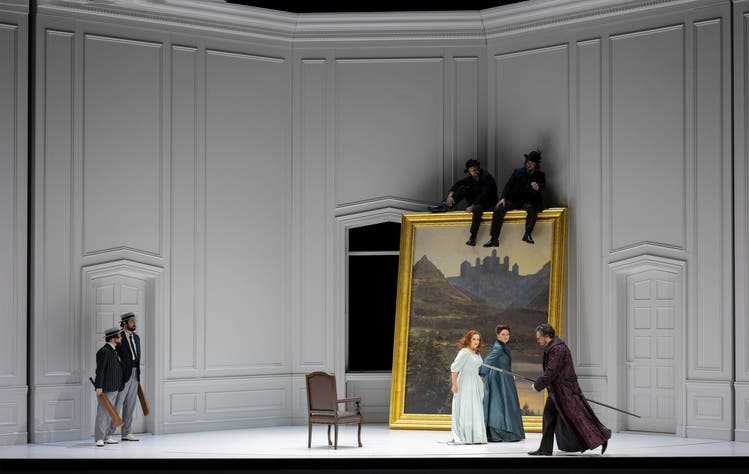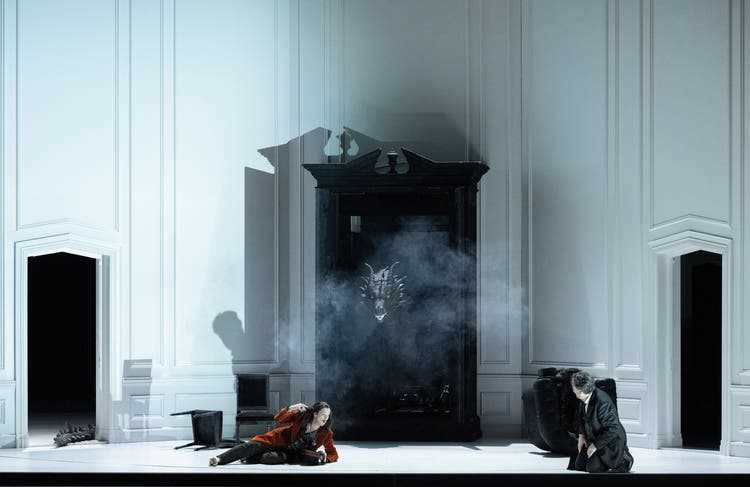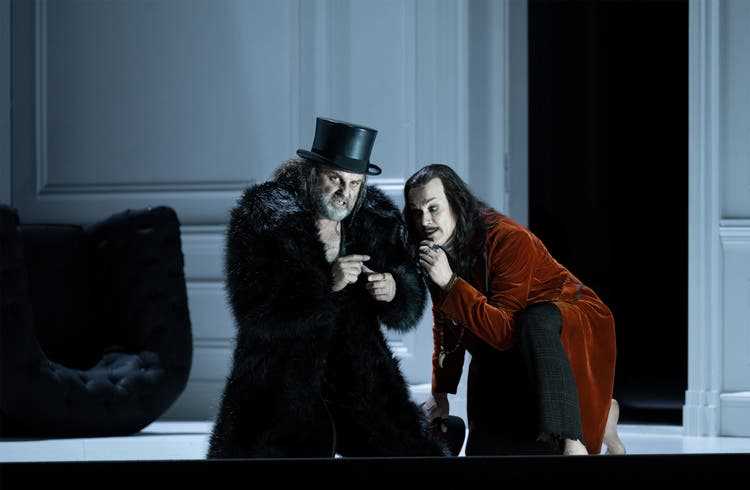The Zurich new production of Richard Wagner’s cycle “Der Ring des Nibelungen” begins with the premiere of “Rheingold”. Where the journey is going remains unclear, but there is already a promising concept in the orchestra pit.
Wotan (Tomasz Konieczny) has snatched the ring from Alberich (Christopher Purves), which gives its wearer unlimited power. However, he will not remain in the hands of the father of the gods for long.
The world is a castle and it keeps turning. It is probably halfway between Zurich and Lucerne, but we don’t know any more details for the time being. Strictly speaking, we only see a few suites of rooms from the proud Alpine fortress, clinically white and with the same triangular rooms; Inside is a bed, a magic cupboard, a picture and a few nuggets of fake gold – the recipe is ready to explain the beginning and the approaching end of civilization.
The basic scenic concept at the start of the new Zurich «Ring» cycle can be summed up in this simple formula, slightly surreal and therefore also a little irritating. With the premiere of the previous evening “Das Rheingold” the first new production of Richard Wagner’s four-part world drama in twenty years begins here. This is also irritating, after all, large parts of this opus summum of European music theater were created just a few hundred meters away from today’s opera house.
The desire for a new interpretation of the tetralogy had existed for a long time. All the more urgent since hardly anyone was really happy with Robert Wilson’s previous production, which was realized in 2002. The American theater magician primarily translated the complex game of love, power and betrayal into beautiful images, but largely refrained from interpreting it. Andreas Homoki, the director of the opera house, now wants to remedy the situation with a new production planned for the 2024/25 season and at the same time crown his Zurich era. However – and this is the third slight irritation – Homoki has also announced that he will refrain from interpreting it in the traditional sense.
reflection on the theatre
In fact, no other work in the history of opera has been so burdened with interpretation as The Ring of the Nibelung. From the pointed critique of power and capitalism to fascist and socialist distortions to parables of doom in the face of the ongoing destruction of nature, one has already seen all sorts of things, including some that are clever and correct, but just as much that is outlandish.
The idea of reducing the giant play to its core as a highly theatrical “stage festival” (the subtitle) is obvious; it is a legitimate way out that has been used remarkably frequently in recent times. But it also contains the admission that the one universal key, i.e. a contemporary or even contemporary interpretation of Wagner’s spectacle of explaining the world, has not been found – or did not want to be found. In view of the recently intensified ideological differences in the world, it is doubtful that there is no longer such a thing.

The giants Fasolt and Fafner (David Soar and Oleg Davydov, on the picture) demand the agreed payment for the construction of the Valhalla castle of the gods.
In the case of Homoki and his designer Christian Schmidt, however, there are hardly any references to current affairs – they would be an interpretation that goes beyond the text of the work, which one would like to avoid. Only with the overly long table, at which Wotan, the father of the gods, and his fellow gods sit down in the final scene for a kind of family constellation, does the director team allow themselves to allude to comparably monstrous furniture in the Kremlin. Otherwise, however, the intention is to take the events as far as possible into an abstract framework.
However, they are not timeless, the four almost identical play rooms, each with two passageways to the adjoining room and a window in the middle, which probably represent the interior of the Valhalla castle of the gods and circling on the revolving stage throughout the evening. Their interior, but also Schmidt’s elegant costumes, refer to the 19th century, i.e. the Wagner era. That alone is a clear localization, in other words: an interpretation; but the historical context thus called up does not yet develop a clear level of meaning in this first part.

A monster out of the closet: Alberich doesn’t really frighten Loge (Matthias Klink, left) and Wotan (Tomasz Konieczny) with his transformation into a dragon.
Rather, Homoki uses the aesthetically stylized framework to develop the plot in very precise and densely worked acting scenes. He shows the story of the theft of the mythical gold from the depths of the Rhine and the resulting cycle of lust for power, fraud and violence as a naturalistic conversation piece, closer to Ibsen and Strindberg than to symbolism. This allows the moments of the fantastic, such as the appearance of a dragon from the cupboard mentioned, to appear like refractions and sets welcome ironic accents in this quite comical piece.
The performance demands on the singers become even higher as a result. Up to now, only the Bayreuth-hardened Wolfgang Ablinger-Sperrhacke as a mime and the playfully constantly present Matthias Klink as the fire god Loge, whom Klink makes the most dazzling character of this “Ring” part, have succeeded in creating really vivid and gripping role portraits. Christopher Purves is also rightly celebrated for his furious role debut as the shady Alberich. Along with Ablinger-Sperrhacke, Purves is the only one who knows how to use Wagner’s alliteration poem rich in consonants («Kirrt with gold, / only lust for gold!») as a characteristic means of sound and expression.

Loge (Matthias Klink) likes to change sides if need be, in any case he shows a lot of understanding for the shady Nibelungen prince Alberich (Christopher Purves, left).
Tomasz Konieczny, who is actually experienced in the role, remains too pale as Wotan. He presses the high notes, rarely works with the language and has not mastered the scene enough – which is also due to the fact that the production knows how to do far more with the conjurer Loge than with the morally stumbling head of the gods. His heavenly relatives have a solid cast, but remain too tame and unpronounced – probably also because of numerous house and role debuts. All in all, the level on the stage still has to be raised considerably if one does not want to be satisfied with just the upscale city theater in Zurich.
desire to continue
The man in the ditch, Gianandrea Noseda, already offers far more than that. The new general music director of the house is also a “Ring” debutant, but he has audibly developed a very coherent and independent approach to Wagner with the Philharmonia Zürich. Anyone hoping for the thunderstorms of sound that are usual in Bayreuth will be disappointed. Noseda’s Wagner is dynamically balanced and sounds pleasantly civilized; nonetheless, Noseda exploits the entire spectrum, both soft and loud, without overpowering the singers. Instead of the usual brass dominance, one hears subtly coordinated woodwind lines and myriad subtleties in the strings. Rarely has a conductor coped so well with the potty, dry acoustics of the Zurich Opera House.
Noseda’s tempi are fluid throughout, some even unusually fast. Transitions are not stretched out, and in keeping with the staging, not every moment is overloaded with meaning. Noseda designs the two and a half hours of music as a symphonic stream, not as a sequence of individual events. It is fitting that he does not display the famous leitmotifs symbolically, but rather lets them sing melodically and unfold. This approach is already making you want to continue with the premiere of “Walküre” on September 18th.
